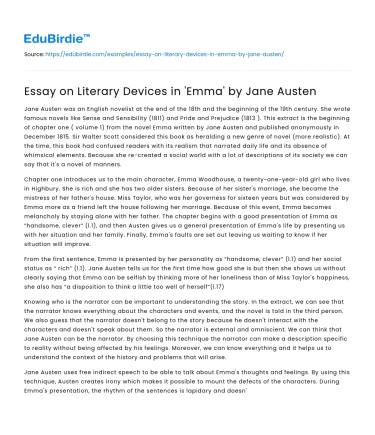Jane Austen was an English novelist at the end of the 18th and the beginning of the 19th century. She wrote famous novels like Sense and Sensibility (1811) and Pride and Prejudice (1813 ). This extract is the beginning of chapter one ( volume 1) from the novel Emma written by Jane Austen and published anonymously in December 1815. Sir Walter Scott considered this book as heralding a new genre of novel (more realistic). At the time, this book had confused readers with its realism that narrated daily life and its absence of whimsical elements. Because she re-created a social world with a lot of descriptions of its society we can say that it's a novel of manners.
Chapter one introduces us to the main character, Emma Woodhouse, a twenty-one-year-old girl who lives in Highbury. She is rich and she has two older sisters. Because of her sister's marriage, she became the mistress of her father's house. Miss Taylor, who was her governess for sixteen years but was considered by Emma more as a friend left the house following her marriage. Because of this event, Emma becomes melancholy by staying alone with her father. The chapter begins with a good presentation of Emma as “handsome, clever” (l.1), and then Austen gives us a general presentation of Emma's life by presenting us with her situation and her family. Finally, Emma's faults are set out leaving us waiting to know if her situation will improve.
Save your time!
We can take care of your essay
- Proper editing and formatting
- Free revision, title page, and bibliography
- Flexible prices and money-back guarantee
From the first sentence, Emma is presented by her personality as “handsome, clever” (l.1) and her social status as “ rich” (l.1). Jane Austen tells us for the first time how good she is but then she shows us without clearly saying that Emma can be selfish by thinking more of her loneliness than of Miss Taylor's happiness, she also has “a disposition to think a little too well of herself”(l.17)
Knowing who is the narrator can be important to understanding the story. In the extract, we can see that the narrator knows everything about the characters and events, and the novel is told in the third person. We also guess that the narrator doesn't belong to the story because he doesn't interact with the characters and doesn't speak about them. So the narrator is external and omniscient. We can think that Jane Austen can be the narrator. By choosing this technique the narrator can make a description specific to reality without being affected by his feelings. Moreover, we can know everything and it helps us to understand the context of the history and problems that will arise.
Jane Austen uses free indirect speech to be able to talk about Emma's thoughts and feelings. By using this technique, Austen creates irony which makes it possible to mount the defects of the characters. During Emma's presentation, the rhythm of the sentences is lapidary and doesn't change. It can show us how confident Emma is.
Did you like this example?
Make sure you submit a unique essay
Our writers will provide you with an essay sample written from scratch: any topic, any deadline, any instructions.
Cite this paper
-
APA
-
MLA
-
Harvard
-
Vancouver
Essay on Literary Devices in ‘Emma’ by Jane Austen.
(2024, February 23). Edubirdie. Retrieved December 22, 2024, from https://edubirdie.com/examples/essay-on-literary-devices-in-emma-by-jane-austen/
“Essay on Literary Devices in ‘Emma’ by Jane Austen.” Edubirdie, 23 Feb. 2024, edubirdie.com/examples/essay-on-literary-devices-in-emma-by-jane-austen/
Essay on Literary Devices in ‘Emma’ by Jane Austen. [online].
Available at: <https://edubirdie.com/examples/essay-on-literary-devices-in-emma-by-jane-austen/> [Accessed 22 Dec. 2024].
Essay on Literary Devices in ‘Emma’ by Jane Austen [Internet]. Edubirdie.
2024 Feb 23 [cited 2024 Dec 22].
Available from: https://edubirdie.com/examples/essay-on-literary-devices-in-emma-by-jane-austen/
copy






 Stuck on your essay?
Stuck on your essay?

